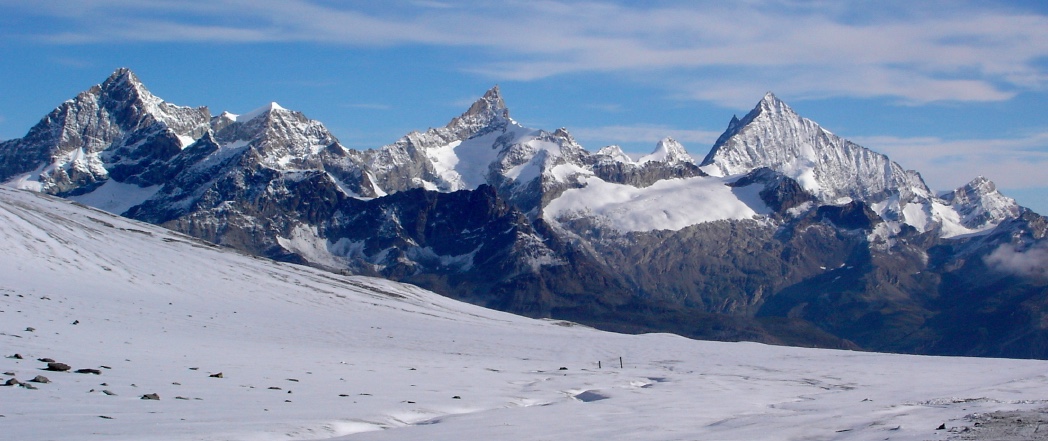
I first set eyes on the Weisshorn in 2006, mid-way through a trek known as the Tour of the Matterhorn. As we crossed into Switzerland, over the Theodulpass and past the Matterhorn, the huge pyramid of the Weisshorn appeared at the end of a row of incredible peaks, the highest and most massive of them all, at 4506m. Until then, the Matterhorn, which was plastered in snow and thus out of condition, had commanded our attention, but now I could not take my eyes off the Weisshorn, and it was to dominate our attention for the next two days as we walked down the Oberer Theodulgletscher, through Zermatt, and along the Europaweg above the Mattertal.
To traverse this enormous peak is a huge undertaking. It is remote, served by no cable cars, scarred by no skiing development, and stands supreme. It demands respect and wonder, and its distinctive form is recognisable for miles around. Irishman John Tyndall was the first to climb it, via its East Ridge in 1861, when the Golden Age of Mountaineering was in full swing. It is a mountaineer’s mountain, bereft of the crowds on the Matterhorn or Mont Blanc, and is surely the Alps’ most esoteric peak.
Paul McWhinney of the Alpine Club had more than once told me what a fine expedition it was to traverse the peak via its East and NNW ridges, and it was with another Paul, Paul Winder, the AC’s newest member, and a friend and occasional climbing partner of mine for many years, that I found myself in Zinal, gearing up to make an attempt. Paul was fresh from a successful climb up the Obergabelhorn’s Arbengrat, and I was hoping that my time in Peru’s Cordillera Blanca some six weeks earlier would help me shrug off any effects of altitude.
First we climbed to the Cabane d’Arpitetta at 2786m, a beautiful small refuge run by two friendly gardiennes. We arrived as the heavens opened and they were impressed by our timing, and that I’d made it in a day trip from London. We, in turn, were impressed by the food and wonderful hospitality they offered, and the views of the Valais peaks, now familiar to both of us. We met two young guides who were going to attempt the Younggrat on the Weisshorn’s Grand Gendarme, which is rarely done and seemed an unlikely prospect after the late afternoon storm. The mountain was swathed in mist and rain and snow, and all seemed rather improbable.
We, instead, had a late breakfast the next morning, and headed off to the Crête de Milon, an ‘Assez Difficile’ route which would serve as a perfect warm up, and hopefully give us a chance to inspect the Weisshorn. All went well after a little route finding and some loose rock and wet slabs slowed us, but we thoroughly enjoyed moving together on the steepening ridge with its ever-improving rock, and it eventually deposited us on the Tête de Milon at 3693m. There we headed down a snow shoulder, which soon led to an icy and crevassed glacier descent. It was awkward and steep for a short time, but easily protected with the odd ice screw, where the dirty snow and ice left us uncertain about what chasms lay beneath, before the angle eased. Soon we were at the Cabane de Tracuit at 3256m, in time for a short sleep before dinner, having again avoided the late afternoon storm. From here we hoped to launch an attempt on the Weisshorn.
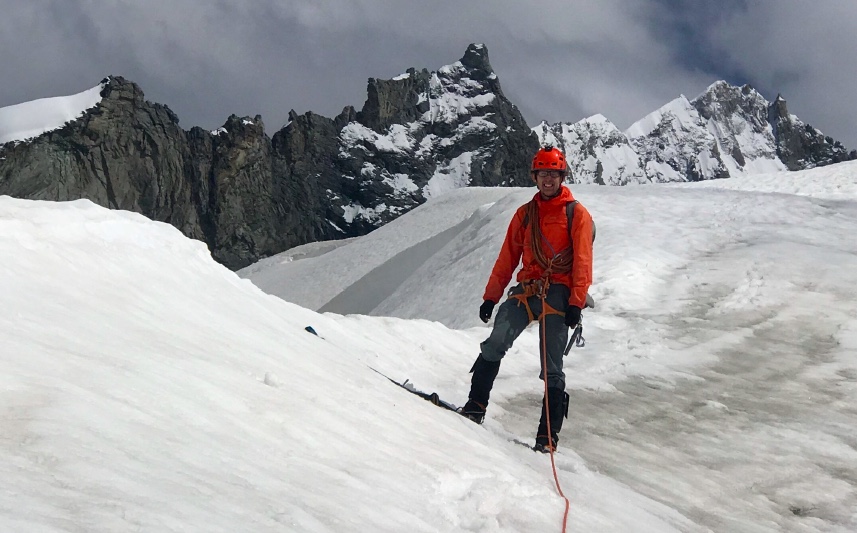
Paul on the Tête de Milon, with the Weisshorn’s NNW Ridge behind
The Tracuit is one of the modern Swiss huts and has one side made up entirely of huge windows, which teeter over an abyss and offer outstanding views of the Valais Peaks to the South West. As the driving rain lashed against these, we established that the ongoing forecast was not good, and decided that we would stay here for a rest day, and then hope to climb the next day. As the storm did its worst, with dramatic cloud formations and a magnificent double rainbow, we caught occasional glimpses of the Weisshorn’s impressive NNW ridge and its Grand Gendarme. It was impossible that our route would be in condition. All this rain would be falling as snow higher up, making the rock sections treacherous and the snow deep. We knew too that by waiting two days, the weather would improve, but that seemed too long to wait, beyond our budget, and it would be the weekend. Taking a stroll outside, I happened to meet the two guides we had met at Arpitetta. They looked spent, having been underway for 16 hours. Too exhausted to look pleased, they explained that on their descent, they had been up to their knees in 50cm of fresh snow. How they had climbed the badly protected damp slabs on the Younggrat in the early hours I could not think. They warned that the Weisshorn’s final snow ridge (not on their route) would be gruelling.
A day off in a well-equipped refuge, staffed by friendly obliging staff, set in breath-taking mountain scenery, is one of life’s great pleasures. We both felt glad of the rest and I found it a good way to rekindle my acclimatisation, whilst we sat and watched further dramatic weather. Paul once again displayed his huge appetite for sleep and I tried my best to emulate him. Late on the second evening, the guardian approached us, brandishing a detailed forecast. The driving rain would stop just in time, and she promised us good weather with some cloud. We decided to make an attempt.

Our day started at 2am with a cheery breakfast for two in the hushed and deserted dining room. The delightful staff had left us Bircher muesli, cling-filmed and decorated with messages of good luck. We set off at 0250 into damp lingering cloud. We found our way to the glacier and onto the well-worn track, which leads to the summit of the Bishorn, our first destination. At ‘Facile’, this is one of the Alps’ easiest 4000m peaks, and there would be a procession of climbers following us after 5am, the normal breakfast time for that peak. But visibility was almost nil, and we soon lost the track, losing valuable time. After 3 hours 20, it was only with my GPS that we were able to locate the summit of the Bishorn at 4153m. We were briefly tempted to turn round, but the weather was clearing, making us feel better about the intense cold, so we donned extra layers and gloves, and set off down the snow ridge for the Weisshornjoch. Paul later admitted he was nervous at this point, and I had to persuade him to continue, with the suggestion that we could always turn back. Soon we got into a rhythm, and we plodded past the col and back up to the first sections of mixed climbing on the crest of the ridge. There was snow on the rocks but our crampons did their job. Eventually we reached the first rock tower and an abseil point, which we knew would be the point of no return. There is no escape from the ridge after this point, other than by abseil down the unpleasantly steep Younggrat, so the only way would be onward. We didn’t hesitate from now on.
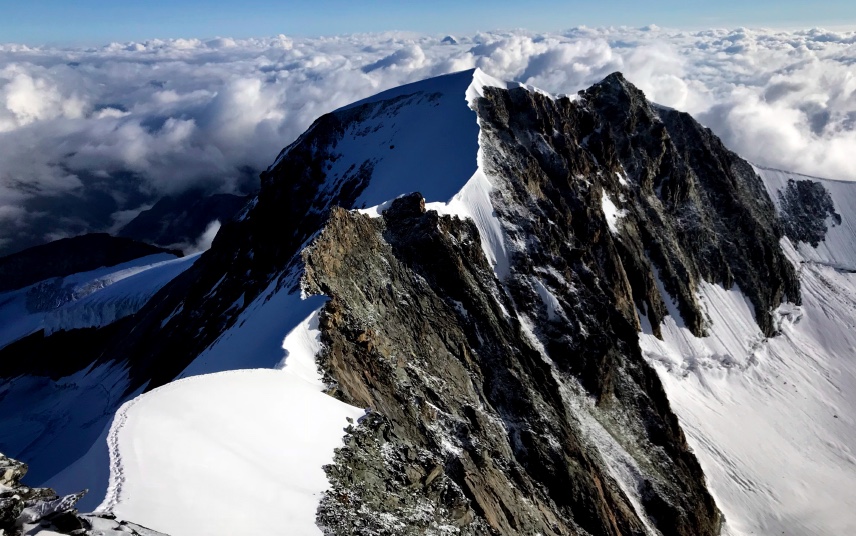
Looking back towards the Bishorn
The next few hours were spent negotiating the exposed crest in a sensational position, moving confidently together and always clipping our rope to at least one point of protection between us. Gradually, gaining and losing altitude, focussed and caring little for the huge exposure, conditions improved, as the sun rose, gently warming the rocks, and we finally reached the foot of the Grand Gendarme which dominates the ridge at a height of 4331m. From a distance it looks impossible to surmount this, but after a 5m traverse to the left, a corner and chimney offer a steep, strenuous and well-protected climb back up to the crest. It was fantastic climbing and I felt pleased that Paul grunted loudly after me up this, definitely the steepest rock climb I have done in crampons.

Exposed climbing on the crest
We bypassed the summit of the Grand Gendarme to its left, and soon reached a long and winding snow arête, which we could see would lead us to the summit. Far ahead, its cross was now visible, but it would be a good couple of hours before we reached it, as it proved a brutal slog breaking trail up the fresh snow. Now confined to the snow ridge, the huge drops on either side became more difficult to ignore, as we plunged our boots into the soft and unpredictable kneedeep snow, but we plodded on upward. We were happy with the weather, which had become more stable and even warm, with billowing clouds swirling past the familiar summits all around us, but our pace was a matter for concern and we were far behind schedule. This was not a classic alpine day. Mostly one climbs in the best and most settled of weather, and today the mountain was completely deserted. We were constantly reminded of the storms that had been rolling in each afternoon. This was no place to be caught in one. Safety first! Paul did not allow me to rush.

The final snow ridge, with the Grand Gendarme behind
At 1345, elated, we finally reached the summit of the Weisshorn at 4506m. The world was at our feet. This huge pyramid of ice and snow towering above the Valais Alps, we had it all to ourselves. We felt a strong sense of solitude, which was to become all the more intense on the descent which lay ahead of us. The summit, however, was a pleasant place to sit and gaze down at the NNW Ridge we had climbed. The Bishorn below seemed benign and distant, and the parties, for whom that was the destination, were no doubt grateful for the tracks we had left them. But there was nothing benign about the ground we had covered thereafter, graded at AD+, III+, and significantly harder in these conditions, an involved ridge of more than 2km, with steep rock steps and towers, then our tracks leading proudly upwards on the shining snow.
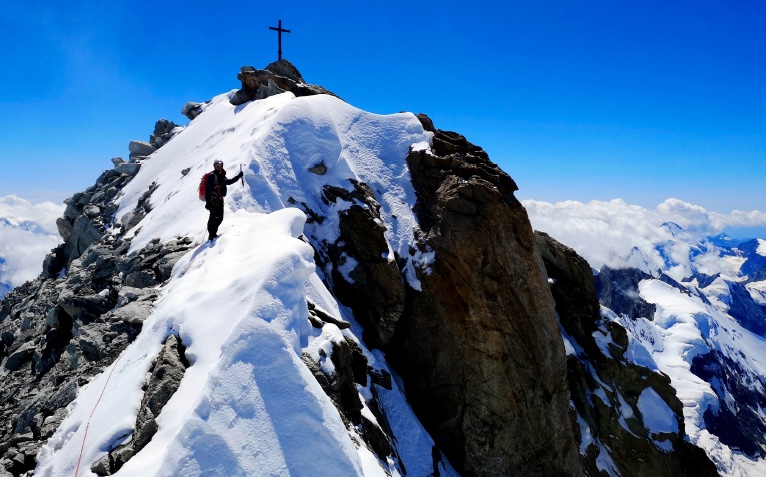
The summit beyond
After a little food, we headed down to the East Ridge. A short descent led to a snow slope, which gradually steepened to over 45°. I was sure we would now speed up, with gravity on our side, but the recent sustained high temperatures had rendered this the most delicate part of the climb. We soon turned to climb backwards down a thin layer of unconsolidated sugary snow, beneath which was hard ice. This was the worst time of day to be on this type of ground. I was anxious to speed on down but Paul stubbornly refused, and when a foot or axe placement occasionally gave way, I knew his caution made sense. Now all our concentration and strength was spent on avoiding a slip, both of us aware that the rope was now more of a liability than a safety net. Neither would have been able to hold a fall if the other had gone. Swinging each boot in turn, I tried as hard as I could to kick steps for Paul, but they simply disintegrated when he reached them, revealing the ice beneath. It was an endless slog. We took frequent rests and fixed our gaze on the rock ridge 400m below. This exhausting descent was a turning point, and we now knew we were well behind schedule and running dangerously low on energy after well over 12 hours on the go.
It was with relief that we reached the rock section of the East Ridge. Here we took off our crampons, and any sense of frustration I’d felt about Paul’s pace melted away as he headed down the ridge, once again placing gear as he went. We were both suffering, our water bottles empty, and I knew that this was the moment to let Paul forge on. I had done my bit, breaking trail, and now Paul’s superior rock climbing and route finding skills came to the fore, and helped him forget the pounding headache he was developing. The ridge was now in perfect condition and free of snow, and thankfully we found the climbing rather easier than on the NNW Ridge. We climbed over several towers, with a few short abseils, admiring magnificent views of the Matterhorn and Dom to our right. The cloud was building, but never threatening, and we soon took more breaks to try to regain some strength. These only served to discourage me somewhat, as, looking down, I realised we still had well over 1000m to descend to the Weisshornhütte, which we could now see in the distance. If only we can get to the glacier by dark, I thought to myself.
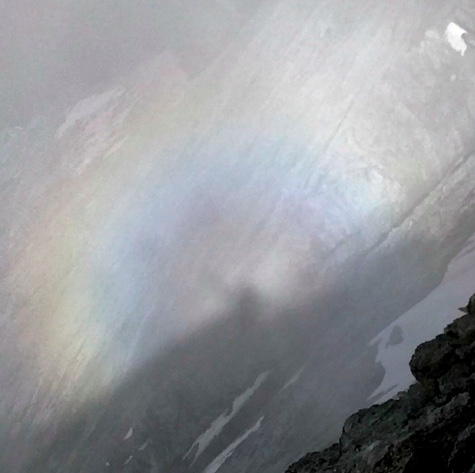
Brocken spectre
As we continued, a Brocken spectre appeared down to our left, a good omen which seemed to lead us on. My silhouette, encircled by a beautiful cloudy white and multicoloured halo, waved back at me. The next landmark was the Lochmatterturm at 3914m, where we knew to turn off the ridge for a steep scramble down to the right. A plaque on the tower marks the point where the guide Franz Lochmatter fell to his death with his client in 1933. This delicate section is now protected by a metal spike and a bolt, which allowed us to abseil over the small overhang. It had taken over 5 hours to descend 600m, but Paul pressed on down and, in my fatigue, I kept thinking how sloppy my rope-work was. Once off the ridge we knew the rope was superfluous but we felt dazed and it seemed pointless to lose time taking it off. Looking at my watch at 1915, I wondered if we would ever make it, with such a huge drop in altitude still to negotiate. As our fatigue grew, we became irritable and short with each other. Was this supposed to be enjoyable?
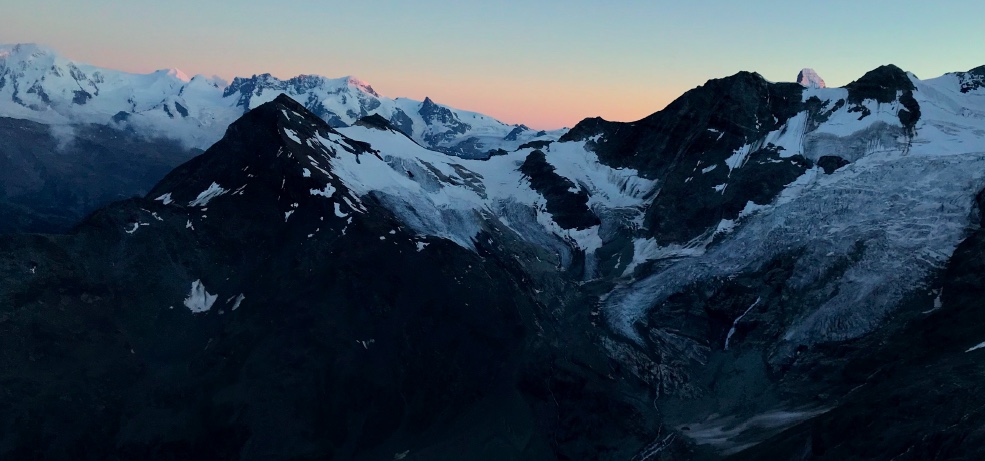
Valais Peaks to the South, after sunset
A final abseil brought us to a short snowfield and another broad rock ridge. Paul now stopped again and I fed him with my dextrose tablets. Communications now seemed to fail completely. Irritated that Paul could only tell me how knackered he was, I plodded wearily on, and eventually we reached the glacier where we put our crampons back on. We crossed a couple of moraines, and it was now dark, but with our head torches we made out the tracks made by climbers on the glacier on this, the normal route. I phoned the guardian to apologise for our lateness, and when we reached the side of the glacier where there is a good path to the hut, any tension between us dissolved into relief, as we realised the end was in sight, a team once more.
At 2230, we finally arrived at the Weisshornhütte at 2932m, and were greeted by Hans Peter and a warm welcome. Soup, water and cheese slowly revived us, not to mention a victory beer. That soup I will never forget! We knew Hans Peter would be up again before 2am to feed and send off climbers up the East Ridge, so we soon staggered upstairs to collapse in amongst the row of sleeping bodies, too tired to sleep or feel elated. Instead I mused on what an ordeal it had been, one which Paul called ‘type-2 fun’. Slowly the sense of achievement began to dawn on us. It is unusual to be on a 14- hour route for nearly 20 hours, way over guidebook time, completely alone on such an iconic mountain, but we knew what an achievement it was to be down safely, having worked well as a team, in conditions that many would have shunned. The next morning we enjoyed a leisurely breakfast and chatted with the other guests, before making our way down into the Mattertal for the 80km journey back to Zinal by train and bus, to retrieve our car.
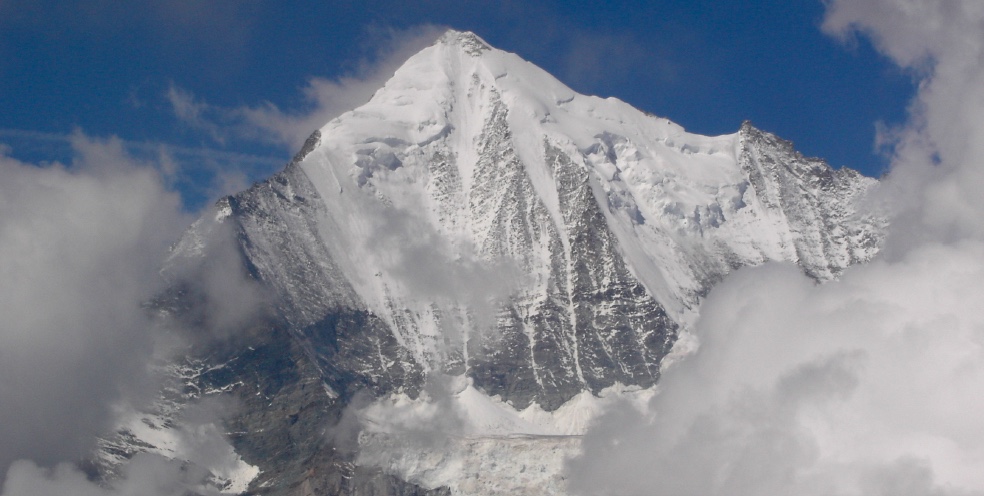
From right to left, the NNW and East Ridges of the Weisshorn, 4506m, in 2006.
This was a seminal moment in my alpine career, but one which it was almost impossible to appreciate whilst underway. In spite of the scale of the undertaking, I felt confident that our experience would help us complete the route, and I had to pinch myself to try take it all in, and to remember and cherish each vivid moment. In the days that followed it began to sink in, slowly and surely, like an alpinist making their steady progress. The Weisshorn had given up its secrets.
Text by Nicholas Smith. Photographs by Nicholas Smith and Paul Winder
